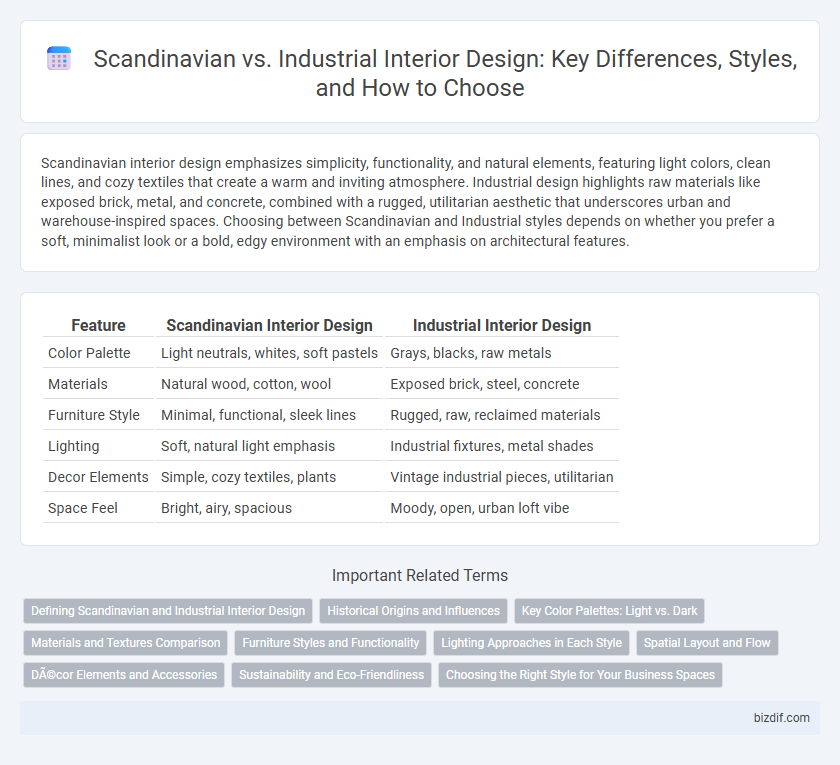Scandinavian interior design emphasizes simplicity, functionality, and natural elements, featuring light colors, clean lines, and cozy textiles that create a warm and inviting atmosphere. Industrial design highlights raw materials like exposed brick, metal, and concrete, combined with a rugged, utilitarian aesthetic that underscores urban and warehouse-inspired spaces. Choosing between Scandinavian and Industrial styles depends on whether you prefer a soft, minimalist look or a bold, edgy environment with an emphasis on architectural features.
Table of Comparison
| Feature | Scandinavian Interior Design | Industrial Interior Design |
|---|---|---|
| Color Palette | Light neutrals, whites, soft pastels | Grays, blacks, raw metals |
| Materials | Natural wood, cotton, wool | Exposed brick, steel, concrete |
| Furniture Style | Minimal, functional, sleek lines | Rugged, raw, reclaimed materials |
| Lighting | Soft, natural light emphasis | Industrial fixtures, metal shades |
| Decor Elements | Simple, cozy textiles, plants | Vintage industrial pieces, utilitarian |
| Space Feel | Bright, airy, spacious | Moody, open, urban loft vibe |
Defining Scandinavian and Industrial Interior Design
Scandinavian interior design emphasizes simplicity, functionality, and minimalism, featuring natural materials such as light wood, neutral color palettes, and clean lines to create airy, bright spaces. Industrial interior design highlights raw, unfinished elements like exposed brick, metal beams, and concrete surfaces, often incorporating vintage or utilitarian furniture to evoke a warehouse or factory aesthetic. Both styles prioritize functional design but differ in atmosphere, with Scandinavian interiors offering warmth and softness, while industrial interiors present a rugged, edgy environment.
Historical Origins and Influences
Scandinavian interior design originated in the early 20th century, influenced by the minimalist principles of functionalism and the natural environment of Nordic countries, emphasizing simplicity, light colors, and natural materials like wood and wool. Industrial design emerged in the late 19th and early 20th centuries, inspired by the industrial revolution and urban factory settings, featuring raw materials such as exposed brick, metal, and concrete, with a utilitarian, rugged aesthetic. Both styles reflect cultural and historical contexts, with Scandinavian design rooted in nature and social welfare ideals, while Industrial design highlights mechanization and urban development.
Key Color Palettes: Light vs. Dark
Scandinavian interior design emphasizes light, neutral color palettes such as whites, soft grays, and pale blues to create bright, airy spaces that enhance natural light. Industrial design favors dark, moody tones like charcoal, black, deep browns, and metallic grays, reflecting raw, urban aesthetics with exposed brick and metal. The contrast between Scandinavian's soft, minimalist hues and Industrial's bold, rugged colors defines their distinctive atmospheres.
Materials and Textures Comparison
Scandinavian interior design emphasizes natural materials such as light wood, wool, and linen, creating a soft, cozy texture palette that enhances minimalism and warmth. In contrast, Industrial design features raw, rugged materials like exposed brick, concrete, and metal, highlighting rough textures and an unfinished, utilitarian aesthetic. Both styles prioritize material authenticity but use contrasting textures to evoke either comfort or industrial edge.
Furniture Styles and Functionality
Scandinavian furniture style emphasizes minimalism, functionality, and natural materials like light woods, often featuring clean lines and muted color palettes that create airy, uncluttered spaces. Industrial furniture style is characterized by raw, rugged materials such as metal, reclaimed wood, and exposed hardware, offering a robust and utilitarian aesthetic suited for urban lofts or modern workspaces. Both styles prioritize durability and practicality, but Scandinavian designs focus on comfort and simplicity, while Industrial designs highlight structural elements and a raw, edgy appeal.
Lighting Approaches in Each Style
Scandinavian interior design emphasizes natural light with large windows, soft white walls, and minimalistic fixtures that maximize brightness and create an airy atmosphere. Industrial style uses raw, exposed lighting elements such as Edison bulbs, metal pendant lamps, and factory-inspired fixtures to add warmth and highlight structural features. Both approaches prioritize functionality but differ in ambiance--Scandinavian lighting seeks to enhance simplicity and natural tones, while Industrial lighting highlights rugged textures and urban aesthetics.
Spatial Layout and Flow
Scandinavian interior design emphasizes open, airy spatial layouts with minimal partitions to enhance natural light and promote smooth flow between rooms. Industrial design often features more segmented spaces with exposed structural elements like beams and ducts, creating distinct zones within an open-plan framework. The spatial flow in Scandinavian interiors prioritizes simplicity and fluidity, while industrial layouts balance functionality with a rugged, layered aesthetic.
Décor Elements and Accessories
Scandinavian interior design emphasizes minimalistic decor elements, featuring natural materials like light wood, cozy textiles, and simple geometric patterns that create a warm, inviting atmosphere. Industrial style incorporates raw, unfinished materials such as exposed brick, metal fixtures, and vintage accessories to convey a rugged and utilitarian aesthetic. Both styles utilize functional accessories, but Scandinavian spaces opt for soft, organic accents while Industrial designs favor bold, metal-based decor pieces.
Sustainability and Eco-Friendliness
Scandinavian interior design emphasizes sustainability through the use of natural materials like wood, wool, and linen, alongside eco-friendly practices such as energy-efficient lighting and minimal waste production. Industrial design often incorporates reclaimed and recycled materials like metal, exposed brick, and repurposed wood, promoting sustainability by reducing demand for new resources. Both styles contribute to eco-friendliness, with Scandinavian design prioritizing simplicity and natural elements, while industrial design focuses on durability and reuse of existing materials.
Choosing the Right Style for Your Business Spaces
Scandinavian interior design emphasizes minimalism, natural light, and functional furniture, creating a clean and inviting atmosphere ideal for businesses seeking a calm, organized environment. Industrial style features raw materials like exposed brick, metal, and reclaimed wood, offering a rugged aesthetic that suits creative agencies and modern startups aiming for an edgy, urban vibe. Selecting between Scandinavian and Industrial depends on your brand identity and the ambiance you want to foster for employees and clients.
Scandinavian vs Industrial Infographic

 bizdif.com
bizdif.com